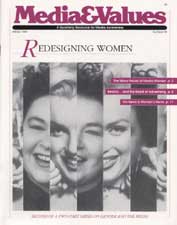Ads Pose Dilemma for Black Women
|
This article originally appeared in Issue# 49
|
For decades, Aunt Jemima, the Quaker Oats' pancake syrup symbol, has been one of the most-recognized trademarks in the world. A hefty figure in her red bandanna, she has also represented a stereotypical portrayal of the black woman.
In late 1989, Aunt Jemima turned 100. In an attempt to keep pace with the '90s and beyond, Quaker Oats celebrated her birthday with a facelift. They discarded the bandanna, subtracted a few pounds, and gave her a new makeup job. Adorned with a pretty lace collar, a Betty Crocker hairdo and small, feminine pearl earrings, she now looks like the "after" photo in a magazine makeover.
Like Quaker Oats, advertisers need to rethink their strategies regarding women of color. Whatever her image, until recently Aunt Jemima stood alone as almost the sole representative of minority women in advertising. For many years, advertisers shied away from using black models, particularly in advertisements for cosmetics and health and beauty aids.
Ironically, if they had done their homework they might have realized the economic potential of using minority women models in advertising these products. According to the American Health and Beauty Aids Institute, African-American women spend up to five times more on personal care products than the average consumer. In fact, by 1993 black women are expected to buy more than 50 percent of the health and beauty aids used in the U. S.
As advertisers awaken to these projections, women of color – better educated, more self-confident and affluent than ever before– are beginning to feel their purchasing power. As black journalist Karen Grigsby Bates wrote in Essence magazine: "I have refrained from sending my hard-earned dollars the way of companies that tell me I don't exist."
Although growing recognition and lessening of stereotypes are welcome, they present women of color with a dilemma. We must remember that we are wanted not for ourselves but for our growing importance in the consumer market. Although we seek full inclusion in society, do we really want to encourage our sisters to buy into the consumer economy promoted by advertising?
Maybe Ms. Bates is right, and as women of color we shouldn't use our green to purchase products until we see more black, brown, yellow and red female faces advertising them. But even when we do, we must remember that appreciation of our purchasing power is a consequence, not a cause, of fuller acceptance in society.



